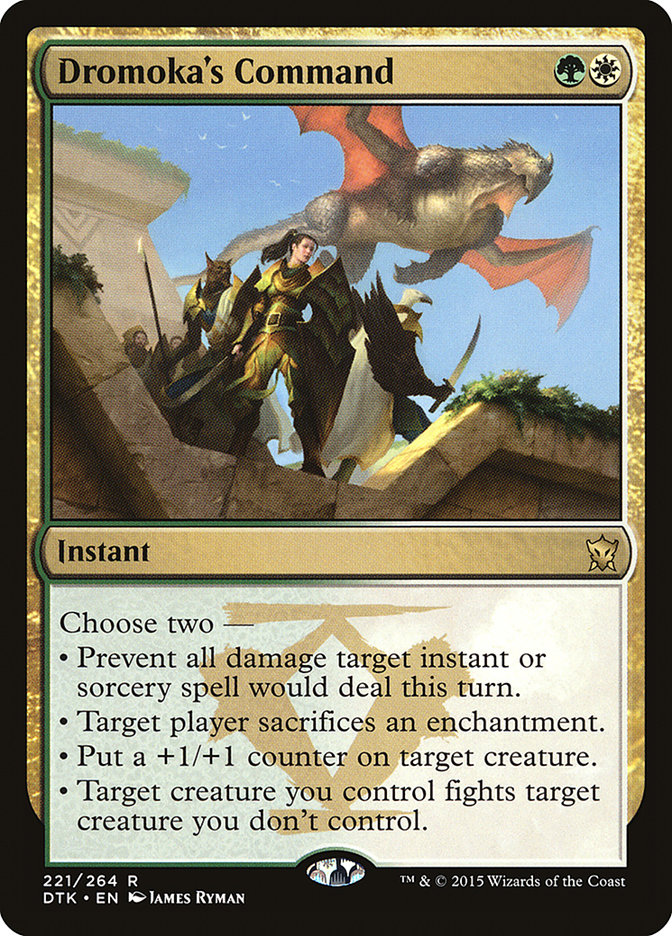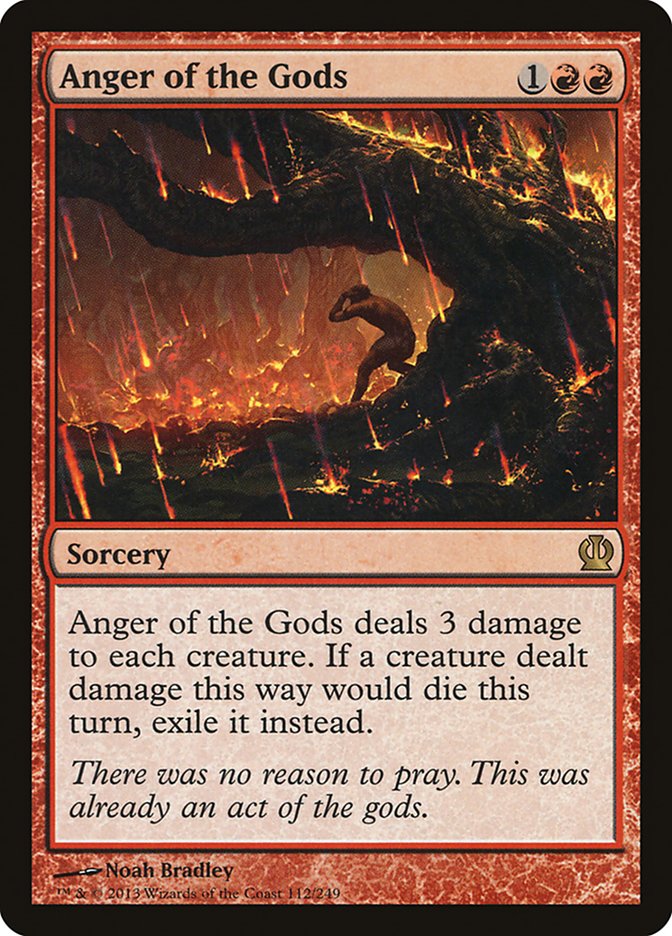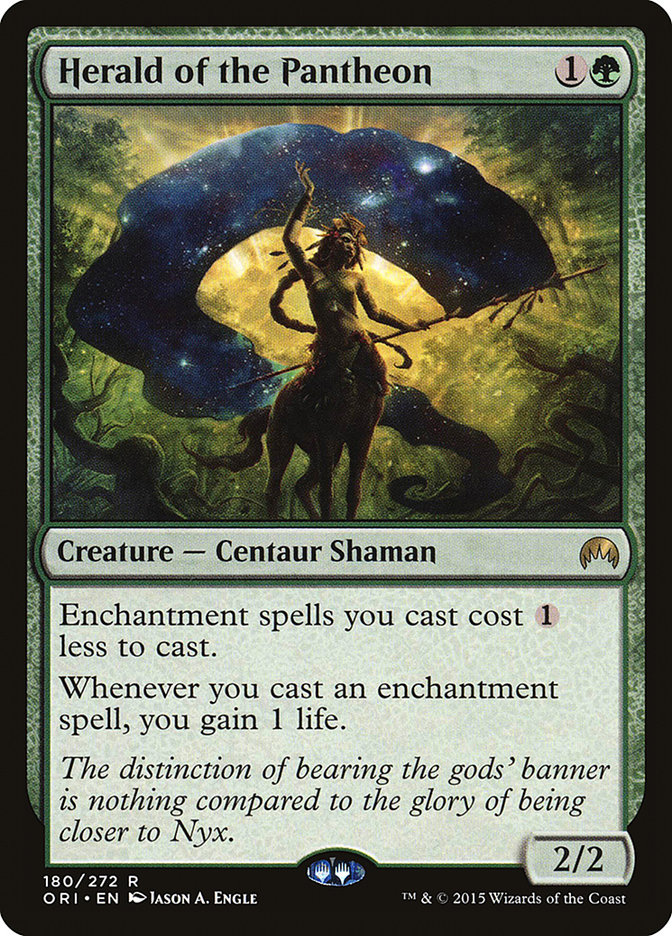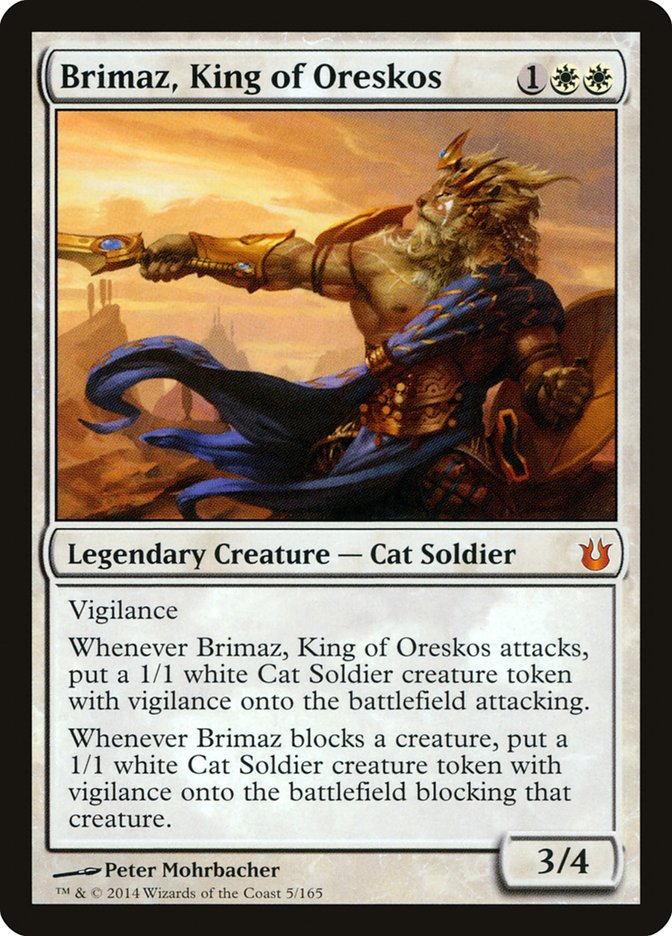What a difference a week makes. At Pro Tour Magic Origins, Mono-Red Aggro was the most popular deck, putting three copies into the Top Eight including champion Joel Larsson. At the Grand Prix, the top-finishing Mono-Red deck was the single solitary copy that made its way into the Top 32. The second-place deck at the Pro Tour, U/R Thopters, which put two copies into that Top Eight, also failed to crack the elimination rounds in San Diego, and also put only one player into the Top 32!
What happened?
Well, just two weeks ago, exactly one player showed up to Pro Tour Magic Origins with G/W Aggro: me. Last weekend, at Grand Prix San Diego, the deck was the second most-common weapon of choice among competitors who made Day Two of the event, putting one copy into the Top Eight, two more into the Top Sixteen, and another four in the Top 32.
Dromoka’s Command is a serious Magic card.
Of course, the rise of G/W isn’t the only reason for the decline of Mono-Red and U/R Thopters. Both decks experienced a great deal of success at the Pro Tour in part because much of the field there was not sufficiently prepared for them. Many players didn’t have any sideboard cards against U/R Thopters at all, and even those who did plan against red decks found themselves with the wrong tools for the job at hand.
Prior to the Pro Tour the most common kind of aggressive red decks were usually built to flood the board with tokens and close out the game with Atarka’s Command. This led to sideboard cards like Drown in Sorrow and Arashin Cleric to mitigate a great deal of their damage potential. But Arashin Cleric can’t effectively block Abbot of Kheral Keep, and Drown in Sorrow does nothing against dash creatures like Lightning Berserker and Zurgo Bellstriker – or the full package of eight four-damage burn spells the new red decks are sporting to finish opponents off.
In San Diego, though, people knew what they were up against. Not only did they have sideboard cards like Pharika’s Cure and Dromoka’s Command to beat the more burn-focused Mono-Red decks, but Unravel the Aether was selling for three dollars apiece at the dealer tables! People were ready.
Of course, being prepared doesn’t just mean having sideboard cards for the decks that did the best last week. It means being ready to beat the decks that people will play to beat the decks that did the best last week! Patrick Chapin explained earlier this week how his testing group, including eventual semifinals finisher Paul Rietzl and PT Origins semifinalist Matt Sperling, decided to play Abzan Control in part because they felt like it was very strong against my G/W deck… which they correctly predicted to be one of the most popular decks among top players at the Grand Prix.
Matt Sperling was one of my losses on Day Two, and he was the only Abzan Control player among the four that I faced to beat me. A big part of his win came from having the right sideboard cards for the job. While I was able to easily beat most of my Abzan opponents who simply brought in additional creature removal spells with my Hangarback Walkers and Evolutionary Leap, Matt correctly anticipated my plan and totally blew me out in the third game with Unravel the Aether. He was able to not only remove a Boon Satyr mid-combat but also take out a Hangarback Walker without triggering its ability. While he only brought in a single copy of Unravel, it gave him a powerful way to interact with some of my best cards against him while my other Abzan opponents struggled to overcome them.
So much of success in Magic metagaming is about being one step ahead of your opponents. I mean seriously… look at the deck that Michael Majors played to win GP San Diego.
Creatures (4)
Lands (27)
Spells (29)
- 4 Anger of the Gods
- 2 Whelming Wave
- 4 Treasure Cruise
- 4 Tormenting Voice
- 1 Dig Through Time
- 1 Monastery Siege
- 2 Roast
- 4 Sphinx's Tutelage
- 2 Send to Sleep
- 1 Alhammarret's Archive
- 4 Magmatic Insight
Sideboard

In what world does Mono-Red win the Pro Tour and then this deck win the Grand Prix a week later? The one in which we actually live, it seems. While this Cuneo-designed masterpiece struggles with aggressive red decks, it absolutely trounces slower decks like Abzan. And, despite the vulnerability of Sphinx’s Tutelage to Dromoka’s Command, four copies of Anger of the Gods plus a pair of Whelming Waves give the deck a lot of powerful tools to beat G/W.
One thing that’s important to recognize about U/R Tutelage, if you’re looking to beat it, is that it is resoundingly not a control deck. It may look like one on the surface since it’s a blue deck with a bunch of card draw, but it doesn’t actually have very many control elements in it. It’s much more of a tempo deck, relying on resolving a Sphinx’s Tutelage and chaining together card draw effects to burn through the opponent’s deck as quickly as possible rather than actually reaching a truly controlling position. It’s not looking to play an attrition game, relying instead on cards that simply delay the opponent like Whelming Wave and Send to Sleep.
The best way to combat U/R Tutelage is to attack the card Sphinx’s Tutelage directly. It may seem strange that the deck was able to be successful in a room that already had disenchant effects against Ensoul Artifact, but amusingly enough the fact that Unravel the Aether shuffles the target into its owner’s library is actually something of a drawback in this matchup. The U/R Tutleage deck plays so much card draw that it can dig to another copy quickly enough to get its engine back online. If you’re looking to beat U/R Tutelage, your best bet may very well be something like Naturalize, Revoke Existence, or Back to Nature – which, incidentally, is also an extremely powerful card against the Abzan Constellation deck that Majors beat in the finals.
Creatures (24)
- 4 Elvish Mystic
- 4 Courser of Kruphix
- 4 Eidolon of Blossoms
- 3 Doomwake Giant
- 1 Pharika, God of Affliction
- 4 Brain Maggot
- 4 Herald of the Pantheon
Lands (24)
Spells (12)

Abzan Constellation was in the back of everyone’s mind when Magic Origins came out thanks to the powerful new offerings from the set in Herald of the Pantheon and Starfield of Nyx. A handful of players put up strong finishes with Constellation at the Pro Tour, but there wasn’t a lot of hype for the strategy coming out of the event. Artur Villela managed to put Abzan Constellation on the map with his second-place finish at the Grand Prix, while Eugene Hwang just missed the elimination rounds on tiebreakers playing the G/W version.
It’s interesting to see that multiple enchantment-based decks were able to perform so well despite the popularity of Unravel the Aether. While U/R Tutelage can simply find another copy of Sphinx’s Tutelage easily with its card draw effects, Abzan Constellation’s card-drawing power relies fairly heavily on Eidolon of Blossoms staying on the battlefield. While the reshuffle effect is something of a drawback in the U/R Tutelage matchup, it’s actually quite the boon against Abzan Constellation since even Starfield of Nyx can’t bring back an Unraveled Eidolon.
Then again, it’s not like a single Unravel the Aether is game over for a Constellation deck by any means. It’s an efficient removal spell, certainly, but it only trades one-for-one in terms of cards. The Abzan Constellation deck, in particular, can also work to protect its key cards with Brain Maggot and Thoughtseize while looking to lean on Eidolon and Kruphix’s Insight to reload and outpace the opponent’s removal.
The cards that Constellation decks really struggles with are the bigger sweeper effects, some of which target the strategy much more directly. As I mentioned above, Back to Nature is likely the best of those although it’s clearly somewhat narrow, and it doesn’t work terribly well in decks with their own enchantments like Courser of Kruphix and Boon Satyr. Tragic Arrogance is more expensive but much more flexible and nearly as powerful. You can choose the same card for multiple types, which means that on a board full of Banishing Lights, Doomwake Giants, and Heralds of the Pantheon, you can leave your opponent with a single Brain Maggot or Courser of Kruphix as their only permanent.
The Abzan Constellation deck is much better set up to deal with Tragic Arrogance than the G/W version since discard effects offer some game against the card, and it also helps that the deck doesn’t rely nearly as heavily on enchantment-based removal like Suppression Field and Silkwrap – Doomwake Giant handles opposing creatures much more permanently. The inclusion of Elvish Mystic alongside Herald also lets the Abzan version get rolling significantly faster, giving opponents less time to set up a good Tragic Arrogance, but it’s still one of the cards Constellation decks least want to face.
Creatures (16)
- 4 Stormbreath Dragon
- 4 Goblin Rabblemaster
- 1 Kolaghan, the Storm's Fury
- 4 Thunderbreak Regent
- 3 Hangarback Walker
Lands (25)
Spells (19)

The last GP San Diego Top Eight deck that I want to highlight for being a step ahead of the metagame is Daniel Ward’s B/R Dragons deck. While the dynamic duo of Stormbreath Dragon and Thunderbreak Regent were among the most-played cards at Pro Tour Dragons of Tarkir, their roars were scarcely heard at PT Magic Origins. The dramatic shift can be attributed to several factors, most notably the rise of G/R Devotion and the printing of Languish.
Many players considered G/R Devotion to simply be a better version of the G/R Dragons decks that were so popular at the last Pro Tour, and indeed, decks that ramped into Dragonlord Atarka instead of her smaller kin were the most-played strategy in Vancouver. That deck had a major target on its head at that tournament and suffered for it, falling prey to aggressive decks like U/R Thopters. Languish, on the other hand, has simply not yet proven to be a major player in the format. It has shown up on the fringes in decks like U/B Control, but no Languish deck has really broken through to achieve a serious foothold in the metagame.
If there aren’t many decks with Languish, why care that your creature base is bad against Languish? Daniel has only a single creature with more than four toughness in his entire deck, but that clearly didn’t stop him from putting up a strong finish.
It’s kind of a funny, because I felt the same way about Stormbreath Dragon in Vancouver. At PT Dragons of Tarkir, my G/W sideboard was packed full of cards like Plummet and Windstorm because Stormbreath Dragon was a popular card and a serious problem for my deck. In Vancouver, however, I didn’t bother to play anything to kill Stormbreath Dragon since I didn’t expect it to be present in many decks. I’m certain Daniel’s Dragons proved to be a headache for many of his opponents in San Diego who chose to play my G/W deck.
 On top of the strength of Stormbreath Dragon, there are a lot of things I like about Dan’s deck. Most notable is the inclusion of Hangarback Walker. We’ve seen the Hangfather showing up in all kinds of decks for any number of reasons, but this is one of the places where I think it makes the biggest difference. One of the weaknesses of midrange red decks in the current Standard for a while has been their lack of good early proactive plays, with many players going as far as playing Mardu just to include something like Soulfire Grand Master or Seeker of the Way. Hangarback Walker offers a strong early play for any midrange deck since it’s a totally reasonable blocker early on against aggressive opponents and a strong threat if you draw it late.
On top of the strength of Stormbreath Dragon, there are a lot of things I like about Dan’s deck. Most notable is the inclusion of Hangarback Walker. We’ve seen the Hangfather showing up in all kinds of decks for any number of reasons, but this is one of the places where I think it makes the biggest difference. One of the weaknesses of midrange red decks in the current Standard for a while has been their lack of good early proactive plays, with many players going as far as playing Mardu just to include something like Soulfire Grand Master or Seeker of the Way. Hangarback Walker offers a strong early play for any midrange deck since it’s a totally reasonable blocker early on against aggressive opponents and a strong threat if you draw it late.
Daniel’s removal package also lines up very well against the field, including opposing Hangarback Walkers. The full four copies of Bile Blight can clean up Thopter tokens, whether from Hangarback or Whirler Rogue, while Magma Spray can alternately kill early mana creatures or exile a Hangarback so it never spawns its flying children. Kolaghan’s Command is a powerful card advantage tool to begin with, but it particularly shines in a world where artifact-heavy decks are a real threat. It can’t kill an Ensouled Darksteel Citadel, but it can deal with just about everything else from the U/R Thopter deck.
Don’t sleep on this deck. Daniel made it to the Top Eight, and his friend piloting the same list ended up in tenth. That’s a pretty remarkable result for a list that wasn’t on anyone’s radar going into the weekend.
Moving forward, these are all important decks to keep in mind in the Standard metagame. It was a lot easier when it looked like things were all about Mono-Red, U/R Thopters, Abzan, and G/R Devotion, wasn’t it? But the shifting face of Standard is what makes the whole thing so fun!
If I were playing in GP London this weekend, this is what I would bring:
Creatures (27)
- 4 Elvish Mystic
- 4 Fleecemane Lion
- 2 Boon Satyr
- 2 Courser of Kruphix
- 2 Hidden Dragonslayer
- 4 Den Protector
- 4 Deathmist Raptor
- 3 Nissa, Vastwood Seer
- 2 Hangarback Walker
Planeswalkers (3)
Lands (24)
Spells (6)

Warden of the First Tree was always something of a curve-filler spot in the maindeck that isn’t amazing in any matchups and is quite poor in some, and I’m happy to free up sideboard slots by replacing it with two of the Hangarback Walkers from the sideboard.
I also added a single copy of Elspeth to the maindeck in place of a Boon Satyr, in large part because Elspeth is the most powerful card in the mirror match and I would expect that to be an important matchup at the Grand Prix. Elspeth also provides an answer to Stormbreath Dragon and is very powerful against G/R Devotion, which is reason enough to include a second copy in the sideboard.
The decline of U/R Thopters and rise of Constellation led me to replace one of the Unravels in the sideboard with a Back to Nature. The third Unravel was certainly a luxury you can afford to cut, and Back to Nature can simply win the game on the spot against Constellation decks so it has a lot of value for a single slot.
Rounding out the new sideboard slots are a pair of Brimaz, King of Oreskos. I’m not totally sure about these, but they seem like the best way to fight back against Anger of the Gods out of decks like U/R Tutelage and they’re also solid creatures against any deck relying on damage-based removal. I don’t like the lion king maindeck because he’s so weak against green creatures, but he’s a solid threat against anyone who isn’t clogging the board with Courser of Kruphix or Deathmist Raptors.
What do you think? So far, in two weeks of premiere events, we’ve seen Mono-Red Aggro and U/R Sphinx’s Tutleage take the titles, about as opposite as two decks can get. Where do you expect Standard to go next?








